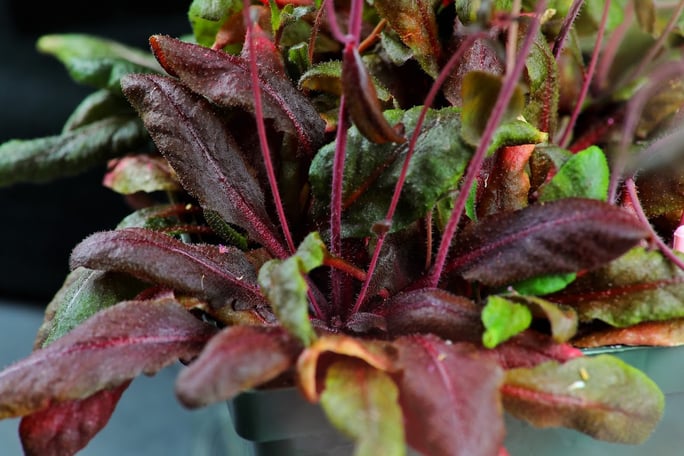Selectable transgene markers for plant transformation fall into two main categories: antibiotic/herbicide resistance and fluorescent proteins. Selection using resistance genes usually involves killing the untransformed seedlings or callus (undifferentiated plant cell culture), which is great for a wide variety of applications. But some techniques require you to select against the presence of a transgene instead, which can’t be done if your selection method kills the transgene free individual.
For example, with CRISPR-Cas9 gene editing, transformation may be identified by resistance to an antibiotic. Successful editing of transformants then typically occurs in T0 plants (from callus) or T1 plants (Arabidopsis floral dip). In the next generation the CRISPR construct needs to be segregated away to prevent continued production of new alleles or off-target gene editing. Antibiotic selection would only then kill the desired plants! PCR or fluorescent markers are currently used in these situations to select against CRISPR positive plants, but screening these can be challenging and requires specialized equipment. Reporters for studying gene expression have similar drawbacks, often requiring the destruction of plants or tissue for GUS staining or are not suited to studying large samples.
RUBY-Red
But recently, something new has been added to the palette. RUBY is a bright red pigment reporter whose expresion is visible to the naked eye in plants. When expressed, the construct produces 3 enzymes from a single mRNA using 2a sites. These convert the amino acid tyrosine to betanin, a member of a class of pigments primarily found in plants in the order Caryophyllales, such as cacti and beets. Betanin belongs to a different chemical family than the red/purple plant pigments found in all other plants, anthocyanins.
|
|
| Figure 1: An adult plant expressing RUBY. Photos by Andrew Willoughby. |
Using RUBY as a selection marker
The creators of RUBY highlight its use in crop plants under field conditions or in sterile conditions where disturbing the tissue for imaging or collection could contaminate it. I have used it for selecting transformation events and am currently planning to use it to simplify my work with an Arabidopsis mutant that can’t set seeds. I study the development of the mutant plants, but the seeds needed for experiments can only be collected from heterozygous individuals. Only 1/4 of the descendants of the heterozygous plants, therefore, are useful for research, and they are identified by a phenotype caused by the segregating mutation. Selecting these plants is a learned skill that takes practice and is difficult for new members of the lab or collaborators unfamiliar with these mutant plants. Using RUBY to simplify the identification of these mutants will speed up my work and make it easier to study these mutants.
-min.png?width=746&name=RUBY%20Pathway%20and%20Construct%20(1)-min.png) |
|
Fig. 2: (A) Betacyanin is produced from tyrosine by the activity of 3 enzymes and a spontaneous step. (B) RUBY is a reporter consisting of these three enzymes expressed under the same promoter with self-cleaving 2A site linkages and a terminator. Image from He, Y., Zhang, T., Sun, H. et al. Hortic Res. (2020). |
I can do this by expressing a gene that rescues the mutations, using RUBY as a selection marker. These plants will be red and will be able to produce seeds. However, they will not be useful to study because they will no longer show the effects of the mutation. But ¼ of the offspring from these plants will be green, containing the desired mutation but lacking both RUBY and the construct that rescues the mutation. I will be able to easily choose the green seedlings that don’t have the transgene and save the red seedlings to collect seed for further experiments.
|
|
|
Fig. 3: (Top right) A RUBY-expressing Arabidopsis seed following floral dip transformation next to an untransformed seed from the same plant beginning to germinate. (Top right, second panel) Transformed seedlings can be selected without antibiotics. (Top left) Mature silique (Arabidopsis fruit) with fertilized developing seeds from a homozygous RUBY plant. (Bottom panels) RUBY expression can vary from different transformation events likely due to insertional effects in the genome. (Bottom panel, right) A highly expressing RUBY plant is a vibrant red/magenta while (bottom panel, left) a lower expressing RUBY plant is a pale pink in transparent tissues, or in green tissues is slightly darker or slightly brown. Photos by Andrew Willoughby. |
The ease of observing RUBY compared to other markers lends itself well to nondestructive selection. If RUBY was integrated into a CRISPR system, then tracking the segregation of the CRISPR construct could be achieved much easier than by PCR or a fluorescent microscope. First, red CRISPR-positive transformants can be produced. In the following generation when CRISPR needs to be removed to prevent further editing, then green offspring can be selected instead of red ones. Other innovative uses of RUBY are possible, for example as positive selection of transformed plants to decrease the routine usage of antibiotics which may contribute to the emergence of antibiotic resistant disease. (RUBY-Red: You can’t beet it!)
About the Author
Andrew Willoughby is a graduate student studying plant development and cell-cell communication in the Nimchuk Lab in the Biology Department at the University of North Carolina at Chapel Hill. He has a passion for microscopy and beautiful imaging.
References and Resources
References
He, Y., Zhang, T., Sun, H. et al. A reporter for noninvasively monitoring gene expression and plant transformation. Hortic Res 7, 152 (2020). https://doi.org/10.1038/s41438-020-00390-1
Additional resources on the Addgene blog
Topics: Plant Biology, Plasmid Tags, Plasmids

-min.jpg?width=555&name=correct_RUBY%20Arabidopsis%20(1)-min.jpg)







Leave a Comment